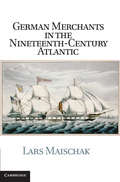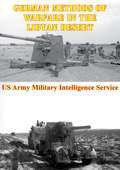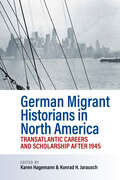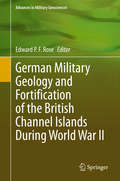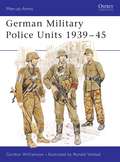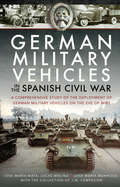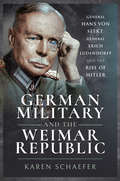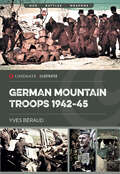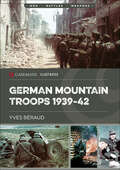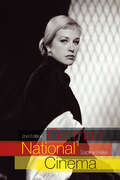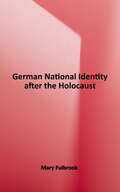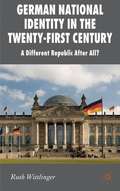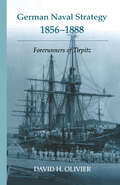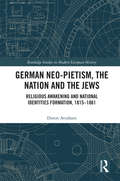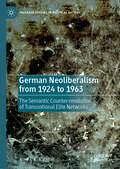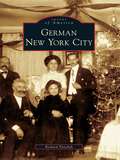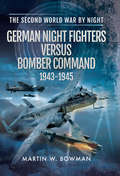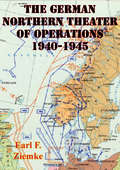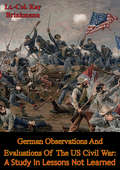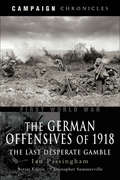- Table View
- List View
German Merchants in the Nineteenth-Century Atlantic (Publications of the German Historical Institute)
by Lars MaischakThis study brings to life the community of trans-Atlantic merchants who established strong economic, political and cultural ties between the United States and the city-republic of Bremen, Germany in the nineteenth century. Lars Maischak shows that the success of Bremen's merchants in helping make an industrial-capitalist world market created the conditions of their ultimate undoing: the new economy of industrial capitalism gave rise to democracy and the nation-state, undermining the political and economic power of this mercantile elite. Maischak argues that the experience of Bremen's merchants is representative of the transformation of the role of merchant capital in the first wave of globalization, with implications for our understanding of modern capitalism, in general.
German Methods Of Warfare In The Libyan Desert [Illustrated Edition]
by US Army Military Intelligence ServiceIncludes the War in North Africa Illustration Pack - 112 photos/illustrations and 21 maps.This book, originally published in 1942 by the U.S. Army's Military Intelligence Service, contains information based on German and British reports explaining German survival and adaptation to the desert. Desert operations have much in common with operations in the other parts of the world. The unique aspects of desert operations stem primarily from heat and lack of moisture. While these two factors have significant consequences, most of the doctrine, tactics, techniques, and procedures used in operations in other parts of the world apply to desert operations. The challenge of desert operations is to adapt to a new environment.
German Migrant Historians in North America: Transatlantic Careers and Scholarship after 1945
by Karen Hagemann and Konrad H. JarauschThe migration experiences, career paths, and scholarship of historians born in Germany who started emigrating to North America in the 1950s have had a unique impact on the transatlantic practice of Central European History. German Migrant Historians in North America analyzes the experiences of this postwar group of scholars, and asks what informed their education and career choices, and what motivated them to emigrate to North America. The contributors reflect on how these migration experiences informed their own research and teaching, and particularly discuss the more general development of the transatlantic exchange between German and American historians in the scholarship on Modern Central European History.
German Migrants in Post-War Britain: An Enemy Embrace (British Politics and Society)
by Dr Inge Weber-Newth Johannes-Dieter SteinertBoth timely and topical, with 2005 marking the 60th anniversary of the end of the Second World War, this unique book examines the little-known and under-researched area of German migration to Britain in the immediate post-war era. Authors Weber-Newth and Steinert analyze the political framework of post-war immigration and immigrant policy, and the complex decision-making processes that led to large-scale labour migration from the continent. They consider: * identity, perception of self and others, stereotypes and prejudice* how migrants dealt with language and intercultural issues* migrants' attitudes towards national socialist and contemporary Germany* migrants' motivation for leaving Germany* migrants' initial experiences and their reception in Britain after the war, as recalled after 50 years in the host country, compared to their original expectations. Based on rich British and German governmental and non-governmental archive sources, contemporary newspaper articles and nearly eighty biographically–oriented interviews with German migrants, this outstanding volume, a must-read for students and scholars in the fields of social history, sociology and migration studies, expertly encompasses political as well as social-historical questions and engages with the social, economic and cultural situation of German immigrants to Britain from a life-historical perspective.
German Migrants in Post-War Britain: An Enemy Embrace (British Politics and Society)
by Dr Inge Weber-Newth Johannes-Dieter SteinertBoth timely and topical, with 2005 marking the 60th anniversary of the end of the Second World War, this unique book examines the little-known and under-researched area of German migration to Britain in the immediate post-war era. Authors Weber-Newth and Steinert analyze the political framework of post-war immigration and immigrant policy, and the complex decision-making processes that led to large-scale labour migration from the continent. They consider:* identity, perception of self and others, stereotypes and prejudice* how migrants dealt with language and intercultural issues* migrants' attitudes towards national socialist and contemporary Germany* migrants' motivation for leaving Germany* migrants' initial experiences and their reception in Britain after the war, as recalled after 50 years in the host country, compared to their original expectations.Based on rich British and German governmental and non-governmental archive sources, contemporary newspaper articles and nearly eighty biographically–oriented interviews with German migrants, this outstanding volume, a must-read for students and scholars in the fields of social history, sociology and migration studies, expertly encompasses political as well as social-historical questions and engages with the social, economic and cultural situation of German immigrants to Britain from a life-historical perspective.
German Military Geology and Fortification of the British Channel Islands During World War II (Advances in Military Geosciences)
by Edward P. F. RoseThis volume discusses how the German armed forces made effective use of military geologists to assist their fortification of the Channel Islands after their capture from the British in 1940. The book presents a unique case history of German geologist expertise applied to British terrain, intended to make the Islands into an impregnable fortress that postwar would remain a permanent outpost of the German state. In doing so, the book explains why the Channel Islands constitute a ‘classic’ location for British geology; how German armed forces made far greater military use of geologists than either their British or American opponents; and the legacy of fortifications that may conveniently be seen by tourists today – fortifications bypassed by Allied forces that liberated nearby Normandy after D-Day in June 1944, and surrendered intact at the end of the War in Europe in May 1945.
German Military Intelligence
by R. H. Stevens Paul LeverkuehnSeldom can the true history of a secret service be revealed but the total collapse of Nazi Germany provided the opportunity and Dr. Paul Leverkuehn has taken it. He was himself a senior member of the Abwehr, Germany's Military Intelligence Service, and one of Admiral Canaris's trusted collaborators. He has sought out some of the most important survivors of the Abwehr, and in this book we have their stories as well as his own. During the war the author was chief of German espionage in Turkey and the Near East and he describes the elaborate intrigues with the Mufti of Jerusalem and Rashid Ali, the Iraqi Prime Minister, whom he smuggled out of Turkey disguised as a German journalist. He tells many other fascinating stories of the Abwehr: that of the man who sailed an agent 14,000 miles to operate against the British in South Africa; of the men who organized the 'Brandenburg Commandos' who operated far behind the Russian lines in enemy uniform; of the mysterious Klatt, who claimed to be in contact with a radio operator inside the Kremlin; of the unmasking of the great Soviet spy organization the Rote Kapelle, which functioned inside the German Air Ministry. He also throws interesting light on the German's use of nationalist minorities; the intrigues with the Flemish nationalists in Belgium; the negotiations with the I.R.A. in Ireland; and the recruitment of Ukrainians against Russia. This book is the first authoritative account of the German Military Service and in important contribution to the history of the Second World War. Print ed.
German Military Police Units 1939-45
by Ronald Volstad Gordon WilliamsonThe military policeman must be one of the least appreciated yet most indispensable military figures in modern history. In the mobile warfare of the 20th century no army could keep its vital supply routes open without the military policeman. This book documents the organisation, uniforms and insignia of the many and varied German military police units of World War II. Their duties included traffic control; maintaining military order and discipline; collection and escorting prisoners of war; prevention of looting; disarming civilians; checking captured enemy soldiers for documents; collection of fallen enemy propaganda leaflets and providing street patrols in occupied areas.
German Military Vehicles in the Spanish Civil War: A Comprehensive Study of the Deployment of German Military Vehicles on the Eve of WW2
by Jose María Mata Lucas Molina José María ManriqueAn authoritative and fully illustrated study of the German military vehicles that fought in the Spanish Civil War—from motorcycles to Panzer Tanks. This comprehensive volume examines the combat and logistics vehicles that formed a vital part of the German contingent fighting in the Spanish Civil War alongside Francisco Franco’s Nationalist forces. The Panzer I, which so surprised the world in the Polish campaign of World War II, was first seen in the Spanish Civil War. It appeared together with a wide range of war materiel such as antitank guns, flamethrowers, and other armaments.This book covers a wide range of vehicles, each identified in detail: from the humblest motorcycle to the Horch staff car; from Opel ‘Blitz’, MAN Diesel, Mercedes, and Krupp trucks to the enormous Vomag 3LR 443 truck; as well as the many types of military ambulances seen in Spain during the war years. With more than 500 historic images—most of them previously unpublished—this volume is an unprecedented study of the vehicles used by the German contingent in the Spanish Civil War.
German Military and the Weimar Republic: General Hans Von Seekt, General Erich Ludendorff And The Rise Of Hitler
by Karen SchaeferThis military biography examines the man who sought to rebuild the Germany Army after WWI—and the rival who stoked the rise of Nazism.After Germany’s devastating defeat in the First World War, General Hans von Seekt became Chief of the Army Command at the Reichewehr Ministry of the Weimar Republic. His job was to rebuild the shattered German army and repair the nation’s standing on the world stage. The punitive terms of the post-war settlement made these ambitious goals nearly impossible, but the most significant challenges von Seekt faced came from within Germany.Von Seekt aimed to build a modern and efficient military with a main strategy of peaceful defense purposes. This original and far-sighted policy was opposed by his rival, General Erich Ludendorff, who led a nationalistic movement seeking revenge for Germany’s defeat. Ludendorff proposed to rebuild the once-mighty German imperial army as a major international force. The failure of von Seekt's experiment was tragically mirrored by the fall of the Weimar Republic, and the rise of rise of Hitler and Nazi Germany.
German Mountain & Ski Troops 1939-45
by Gordon Williamson Stephen AndrewOsprey's study of Germany's mountain and ski troops of World War II (1939-1945). Fighting in every theatre from the burning sands of North Africa to the icy wastes above the arctic circle the German Army's Gebirgstruppen troops were some of the most effective in the whole of the Wehrmacht. Their esprit de corps and morale were extremely high and their commanders, men such as Eduard Dietl, the 'Hero of Narvik', and Julius 'Papa' Ringel, were idolised by their men. Dietl himself was the first soldier of the Wehrmacht to be awarded the coveted Oakleaves to the Knights Cross of the Iron Cross. In this book Gordon Williamson details the uniforms, organisation and combat histories of these elite troops.
German Mountain Troops 1942–45 (Casemate Illustrated)
by Yves Béraud"The author does a terrific job of outlining the many campaigns and areas where the German Mountain troops fought throughout the war, and the unique challenges that some of these areas brought." — AMPSWhen World War II began, the Wehrmacht had fifteen mountain divisions and a multitude of small units, including some Austrian units that had been incorporated into the German army after the Anschluss. These mountain units would operate in hostile environments on all fronts during World War II. Due to their training, equipment and adaptability, the Gebirgstruppen would be deployed to fight in almost every theater. In the last years of the war they would see action in North Africa, Italy, the Balkans, Norway and Finland, and in the West as the Allies pushed German forces back toward Berlin. This book, the culmination of four decades of research and the support of many veterans and collectors, describes the uniform, equipment, and operations of these specialist units during the later years of World War II. The text is complemented by period photographs taken at the front, including many color photographs, and modern photographs of uniform details.
German Mountain Troops, 1939–42 (Casemate Illustrated #20)
by Yves BéraudA pictorial history of the Nazi military’s elite Gebirgstruppen during World War II.Fifteen elite mountain divisions and a multitude of small units fought for the Wehrmacht during World War II. They fought on all fronts, operating in hostile environments ranging from the far north to Libya, the Atlantic to the Caucasus—serving in all the “hot spots.” This book, the culmination of some four decades of research and the support of many veterans and collectors, describes the life, operations and equipment of these specialist units.“A very illuminating study on some of WWII Germany’s finest combat troops in their most successful actions of the early war period.” —AMPS“Supported by a great collection of colour and monochrome photographs - one with the men wearing patterned tablecloths to stave off the cold in Norway is my favourite. . . . It will appeal to readers interested in the German army in the early phases of World War II.” —Wargames Illustrated
German National Cinema (National Cinemas)
by Sabine HakeGerman National Cinema is the first comprehensive history of German film from its origins to the present. In this new edition, Sabine Hake discusses film-making in economic, political, social, and cultural terms, and considers the contribution of Germany's most popular films to changing definitions of genre, authorship, and film form. The book traces the central role of cinema in the nation’s turbulent history from the Wilhelmine Empire to the Berlin Republic, with special attention paid to the competing demands of film as art, entertainment, and propaganda. Hake also explores the centrality of genre films and the star system to the development of a filmic imaginary. This fully revised and updated new edition will be required reading for everyone interested in German film and the history of modern Germany.
German National Identity after the Holocaust
by Mary FulbrookFor over half a century, Germans have lived in the shadow of Auschwitz. Who was responsible for the mass murder of millions of people in the Holocaust: just a small gang of evil men, Hitler and his henchmen; certain groups within a particular system; or even the whole nation? Could the roots of malignancy be traced far back in German history? Or did the Holocaust have more to do with European modernity? Should Germans live with a legacy of guilt forever? And how, if at all, could an acceptable German national identity be defined? These questions dogged public debates in both East and West Germany in the long period of division. Both states officially claimed to have "overcome the past" more effectively than the other; both sought to construct new, opposing identities as the "better Germany". But, in different ways, official claims ran at odds with the kaleidoscope of popular collective memories; dissonances, sensitivities, and taboos were the order of the day on both sides of the Wall. And in the 1990s, with continued heated debates over past and present, it was clear that inner unity appeared to be no automatic consequence of formal unification. Drawing on a wide range of material - from landscapes of memory and rituals of commemoration, through private diaries, oral history interviews, and public opinion poll surveys, to the speeches of politicians and the writings of professional historians - Fulbrook provides a clear analysis of key controversies, events, and patterns of historical and national consciousness in East and West Germany in equal depth. Arguing against "essentialist" conceptions of the nation, Fulbrook presents a theory of the nation as a constructed community of shared legacy and common destiny, and shows how the conditions for the easy construction of any such identity have been notably lacking in Germany after the Holocaust. This book will be of interest to advanced undergraduate and postgraduate students in history, politics, and German and European Studies, as well as established scholars and interested members of the public.
German National Identity in the Twenty-First Century
by Ruth WittlingerWittlinger takes a fresh look at German national identity in the 21st century and shows that it has undergone considerable changes since unification in 1990. Due to the external pressures of the post-cold war world and recent domestic developments, Germany has re-emerged as a nation which is less hesitant to assert its national interest.
German Naval Camouflage, 1942–1945: 1942 - 1945
by John Asmussen Eric LeonSecond in &“the most complete and authoritative set of books ever written on the color schemes used by the Kriegsmarine throughout World War II&” (Great Models). This book completes a highly original and superbly illustrated two-volume survey of German naval camouflage and markings in the Nazi era. On first publication in 2012, the 1939-1941 volume was quickly recognized by warship enthusiasts and modelmakers as a major step forward in the understanding of a complex and much debated topic. It is already considered the standard reference, and this second volume is keenly awaited. Although a few crucial documents have recently come to light, this study is largely based on close scrutiny of all available photos, including many newly discovered, collated with the first-hand testimony of Kriegsmarine survivors. After decades of study, the authors are probably the world&’s leading experts, and their work challenges many accepted views, while greatly expanding the general understanding of the subject. The fruits of their labors are presented in the form of exquisite color illustrations of every scheme and variation for which evidence is available. This volume covers all major surviving ships down to destroyers from 1942 to the end of the war, and adds a new section on torpedo boats. While there can never be a last word on such an elusive and poorly documented subject, these two volumes will remain the most authoritative work in the field for many years to come.&“Impressive, wonderful and indispensable for both historians and modelers or naval wargamers.&” —Miniaturas JM
German Naval Strategy, 1856-1888: Forerunners to Tirpitz
by David H. OlivierThis book is a comparative study of the evolution of the German navy in the second half of the nineteenth century. It examines the development of strategy, especially commerce-raiding, in comparison to what other navies were doing in this era of rapid technological change. It is not an insular history, merely listing ship rosters or specific events
German Neo-Pietism, the Nation and the Jews: Religious Awakening and National Identities Formation, 1815–1861 (Routledge Studies in Modern European History #82)
by Doron AvrahamThis book focuses on the national conceptualization of Judaism and Jews by German neo-Pietists from the early Restoration (1815) until the New Era (neue Ära, 1858-1861), at which point Prussia and other German states embarked on a liberal course. The book demonstrates how a certain understanding of nationalism by Awakened Christians, who were associated with political conservatism, was applied to themselves as belonging to a German nation, and correspondingly to Jews as members of a distinct Jewish nation. It argues that this kind of nationalization by neo-Pietists–among them theologians, intellectuals, and members of the agrarian aristocracy–was interwoven with their religion of the heart, and drew on a tradition of a community of kinship established by the earlier German Pietism since the late seventeenth century. The book sheds new light on the accommodation of nationalism by German Pietist conservatives, who so far were considered as opponents of the national idea. At the same time, it shows that their posture towards Jews was not merely anti-Semitic. It emerged from a specific religious-national synthesis, and aimed at an alternative solution to the Jewish Question, other than emancipation, in the form of Jewish national political independence.
German Neoliberalism from 1924 to 1963: The Semantic Counter-revolution of Transnational Elite Networks (Palgrave Studies in Political History)
by Arne I. KäthnerThis book offers an in-depth study of German neoliberalism between 1924 and 1963, arguing that a neoliberal network was established in the interwar period, decades before elite networks in Great Britain and the United States fostered the ‘neoliberal revolution’ of the Thatcher and Reagan administrations. The author shows how this network strongly influenced societal developments in the 1950s and set a precedent for neoliberal projects in other countries. This success was largely due to the deliberate and strategic reorganisation of the semantic field: abandoning or reacquiring ‘abused’ concepts, challenging existing meanings, or introducing new concepts to the political scene. The book examines the Aktionsgemeinschaft Soziale Marktwirtschaft (ASM), an early neoliberal Think Tank founded in 1953 and led by Alexander Rüstow, which became an influential political actor in post-war West Germany. The author adopts a decidedly transnational approach linking and contrasting inner-German debates with those taking place transnationally among neoliberal proponents in the Mont Pèlerin Society. More than just a political study of ideologies, this book provides a historical account of the conceptual struggles over neoliberalism, the actors who engaged in them, the spheres in which they took place, and the semantic means and conceptual strategies employed, providing useful insights for scholars of German and political history, as well as political science more generally.
German New York City (Images of America)
by Richard PanchykGerman New York City celebrates the rich cultural heritage of the hundreds of thousands of German immigrants who left the poverty and turmoil of 19th- and 20th-century Europe for the promise of a better life in the bustling American metropolis. German immigration to New York peaked during the 1850s and again during the 1880s, and by the end of the 19th century New York had the third-largest German-born population of any city worldwide. German immigrants established their new community in a downtown Manhattan neighborhood that became known as Kleindeutschland or Little Germany. During the late 19th and early 20th centuries, much of the German population moved north to the Upper East Side's Yorkville and subsequently spread out to the other boroughs of the city.
German Night Fighters Versus Bomber Command, 1943–1945 (The Second World War By Night)
by Martin W. BowmanThis new volume from Martin Bowman examines the closing years of the Second World War, as the tide turned against the German and Axis forces. It includes riveting first-hand accounts from German fighter pilots caught up in some of the most dramatic night time conflicts of the latter war years.Viewing Bomber Command's operations through the eyes of the enemy, the reader is offered a fresh and intriguing perspective. Set in context by Bowman's historical narrative, these snippets of pilot testimony work to offer an authentic sense of the times at hand.
German Northern Theater of Operations 1940-1945 [Illustrated Edition]
by Earl Ziemke[Includes 23 maps and 31 illustrations]This volume describes two campaigns that the Germans conducted in their Northern Theater of Operations. The first they launched, on 9 April 1940, against Denmark and Norway. The second they conducted out of Finland in partnership with the Finns against the Soviet Union. The latter campaign began on 22 June 1941 and ended in the winter of 1944-45 after the Finnish Government had sued for peace.The scene of these campaigns by the end of 1941 stretched from the North Sea to the Arctic Ocean and from Bergen on the west coast of Norway, to Petrozavodsk, the former capital of the Karelo-Finnish Soviet Socialist Republic. It faced east into the Soviet Union on a 700-mile-long front, and west on a 1,300-mile sea frontier. Hitler regarded this theater as the keystone of his empire, and, after 1941, maintained in it two armies totaling over a half million men.In spite of its vast area and the effort and worry which Hitler lavished on it, the Northern Theater throughout most of the war constituted something of a military backwater. The major operations which took place in the theater were overshadowed by events on other fronts, and public attention focused on the theaters in which the strategically decisive operations were expected to take place. Remoteness, German security measures, and the Russians' well-known penchant for secrecy combined to keep information concerning the Northern Theater down to a mere trickle, much of that inaccurate. Since the war, through official and private publications, a great deal more has become known. The present volume is based in the main on the greatest remaining source of unexploited information, the captured German military and naval records. In addition a number of the participants on the German side have very generously contributed from their personal knowledge and experience.
German Observations And Evaluations Of The US Civil War: A Study In Lessons Not Learned
by Lt.-Col. Kay BrinkmannHelmuth von Moltke's alleged statement the U.S. Civil War was an affair in which two armed mobs chased each other around the country and from which no lessons could be learned underlines a grave misjudgment of this war in contemporary Germany. Today, however, the American Civil War is recognized as the first modem war. It produced a number of lessons across the strategic operational and tactical levels that shaped the face of war. But the German observers failed to draw significant conclusions at the time. A wide variety of reasons inhibited a thorough and unbiased analysis.This study aims to analyze the German observations and to arrive at the causes that led to the underestimation and disregard of the lessons from the Civil War. The thesis provides a sketch of the Civil War and the situation of contemporary Germany. It then examines the German observers and their evaluations. Thereafter, the author reflects selected essential lessons of the war against the contemporary German military evolution. In a final step the conclusions of these sections will merge into an analysis of the causes, which prevented the German army from arriving at the lessons of the U.S. Civil War.
German Offensives of 1918: The Last Desperate Gamble (Campaign Chronicles)
by Ian PassinghamHe boldly reassesses German military doctrine, the strategic thinking behind the offensives and the effectiveness of the storm troop tactics used. He also considers how the poor state of German military morale and the privations and unrest of the German people contributed to the army's defeat.
